Car in the era of multi-functionality. What transformations are possible?

| “The development of all systems is in the direction of increasing the degree of ideality.” TheUrbanization in the "green" style at its maximum, as if this might sound strange, "does not contain variants using personal electric cars in the city." I will try to explain this controversial but not senseless thesis further on a number of examples, and then I will tell you about an unexpected way out for the car industry from this unpleasant situation.
laws of the development of technical systems (GS Altshuller).
The beginning of the 20th century was marked by the growth of cities as a result of the transition to a new technological order. The conversion of roads in the city was fast, mainly due to cars, but not all cities were affected. There are even now places where such changes did not happen.
"Eternal" cities without cars.
African city - Fez el Bali.

The medieval Moroccan city of Fez el-Bali had no experience in automobilization. This city is part of a world heritage site that is famous for its ancient history and unusually narrow streets. In this historic place there are 9400 steep narrow aisles, the dimensions of which exclude any use of vehicles in principle. Walking and bicycles are the only way to travel around the city. But in some areas of Fez-el-Bali, the width of the streets is barely one meter, so even cycling is impossible here.
Venice

Another historic center without cars is Venice. This city has 117 small islands and 150 channels. The islands of Venice are connected by foot bridges. Instead of traditional roads, the transport arteries of Venice are hundreds of canals. You can explore the city by boat, or during a walking tour. Water taxis are the main form of public transport in Venice. For tourists there are classic Venetian rowboats, gondolas. The city has approximately 350 gondolas, which travel along the Grand Canal (the largest canal in Venice) is the main tourist attraction of Venice. An interesting fact is connected with bicycles, which did not “infringe upon” until 2016, but after they began to prohibit it because of the danger of collisions.
Restrictions for road transport however now apply not only to individual cities, but also to entire islands.
Carless
Islands Lamu Islands Lamu

Island in Kenya is one of the most beautiful destinations in East Africa. It is part of the Lamu archipelago and is a beautiful coastal area without cars. Donkeys are the main mode of transportation on the island, which can be reached exclusively by boat. You can explore Lamu on foot, or on a bike tour.
Hydra Island Hydra

Island is located in the Aegean Sea. Cars on the island are strictly prohibited, which not only prevents air pollution, but also preserves its natural identity. You can choose horses, donkeys or water taxis to explore the island up and down.
Mackinac Island

A small Mackinac Island in Michigan is a popular resort destination in the United States. You can reach this island on a small plane or boat. Travel here without a car, since the use of all motorized vehicles has been banned at Makino since 1898. To get around Makino, there are three options available - carriage, bicycle or walking tours. However, for safety reasons, rescue vehicles and maintenance vehicles are functioning on the island, so this island cannot be called completely deprived of motor transport.
Sark Island

Sark is a picturesque carless island located in the Channel Islands of France. There is no airport here, and the waterway is the only way to get to the island. Excursions are conducted on bicycles or on foot routes. About 600 permanent residents live in Sark, using bicycles or horse-drawn vehicles for movement. For disabled there are special bikes with engines.
All of the above applies only to certain places in the world where, for various reasons, there was no transition to road transport. Previously, there were no prerequisites for expanding the principle of "without a car", but since about the middle of the 20th century, certain steps have taken place in this direction. The problems of ecology and increased injuries due to the movement of multi-ton personal vehicles have become a serious problem for the city. The inevitable noise, vibration and related requirements for maintenance and placement in car parks became the starting point for some cities to make radical decisions to correct the situation.
Cities leading the abandonment of cars in our time.
Vancouver (Canada)

Vancouver stands out from its neighbors. So 50% of movements in the city are already carried out with the help of urban transport, bicycles or walking.
Such changes are not accidental, and the roots of transformations began to sprout half a century ago.
The history of radical changes in the urban space of Vancouver dates back to the late 1960s, when residents opposed the construction of a motorway through the city center. Thus, Vancouver today remains the only major North American city, through whose center major highways do not pass, and therefore it is preserved the convenience of moving without traffic jams, noise and other related disadvantages of ordinary cities.

Vancouver Municipal Railway Transport System - SkyTrain
Then, in 1986, the World Expo'86 Exhibition was held on the city embankment on international transport issues, which was the first to introduce the new automated urban rail system SkyTrain, which became one of the longest fully automated metro systems in the world. The new transport project paved the way for the rapid transformation of urban areas, which made it possible for many residents not to use road transport for intracity movements.
Already in 2015, the city achieved the goal outlined under the Greenest City 2020 plan - to create the necessary conditions for 50% of Vancouver residents to leave their cars at home more often and move around the city with convenient and efficient public transport or bicycles. Vancouver also hosts a “car-free day” in June every year, during which a ban is imposed on cars in busy neighborhoods of the city, and numerous street festivals are held there, which are visited by up to 500,000 residents and tourists.
The Vancouver authorities are planning to further promote the popularity of public and light personal transport in order to achieve a new ambitious goal by 2040 - to make sure that 66% of all urban movements fall on public transport, as well as cycling and walking.
Oslo (Norway)

Estimated future pedestrian area of Oslo, according to data from the Norwegian Broadcasting Corporation NRK.
In the Norwegian capital, by 2019 they plan to introduce a ban on cars in the center. According to the new state development program, the same step awaits all other cities in Norway until 2025, with a positive development of events.
This step will be the first large-scale permanent ban among all European capitals, and already today has stimulated a large number of investments in public transport. In addition to pedestrians and cyclists, the city center will remain accessible to city buses and trams, as well as to vehicles carrying people with disabilities, grocery trucks and public transport.
Today, Oslo is home to a little more than half a million people, which account for almost 350,000 cars, most of which are concentrated in the suburbs of Oslo.
Helsinki (Finland) The

Finnish capital in the coming decades expects rapid population growth. But no matter how paradoxical it may sound - the more people will appear in the city, the fewer cars will remain in it. All because of the new development plan of the city, according to which the car traffic should be mainly transferred to the suburbs. The center of the capital is planned to serve only public transport.
Today, Helsinki is also introducing a number of innovative ideas designed to increase the number of people who refuse private cars. One of them is a special mobile application that allows you to find a bicycle for a short time, call a taxi, find a tram or bus stop. Such is the national Uber 3 in 1 in Finnish.
Chengdu (China)

This city in the southwest of China can serve as a model for many Asian megalopolises. Its streets are designed so thoughtfully that you can reach any point on foot in no more than 15 minutes, without having to solve a map of the city. The general plan of the city does not completely prohibit cars, but assigns only half of all roads for them, and on the other - cyclists move.
Madrid, Spain)

It has already banned the movement of private cars on some streets of the city. 24 pedestrian streets are planned to be converted into pedestrian streets, and fines for traveling in the wrong places are already up to one hundred euros. Parking is the same as soon grows in price in the central areas, so it is better to leave the car away from the center, if you want to save. Further, the prospect is even less rosy. Madrid authorities until 2020, plan to introduce a large-scale ban on the movement of cars in the center of the city, which will cover an area of more than 2 square kilometers. At the same time, city planners are re-designing the 24 busiest streets of the Spanish capital, reorienting them for pedestrian and cycling use.
The initiative is part of the "2020 Mobility Plan" - a global plan to create an environmentally sustainable transport system of the city, the purpose of which is to reduce the frequency of car use.
As the central part of the city gets rid of automobile lanes, more than 2/3 of the vacated street space will be equipped for pedestrians and cyclists. On the outskirts of the pedestrian zone will be located 13 large parking lots, where everyone can leave their cars to stroll through the center of Madrid. The only exceptions to the rules will be to benefit only the indigenous people of the central areas of the city, but given the general trend of reorienting the space for cycling, this may not be for long.
New York, USA)
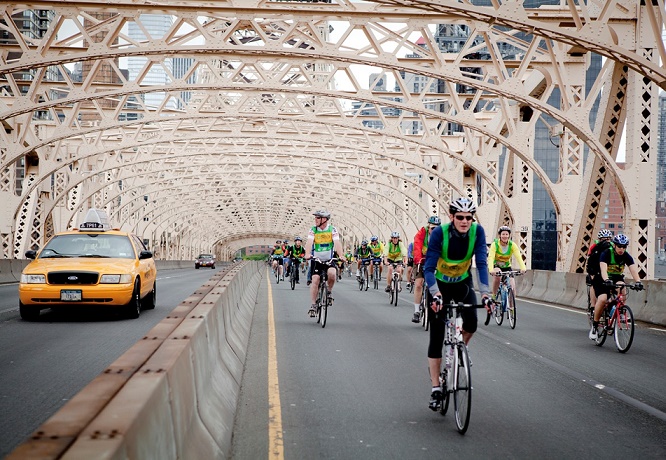
Despite the fact that the plans of the New York authorities do not have a clause on the permanent ban on cars, the number of walking and cycling paths tends to increase, along with options for traveling on public transport. Today, parts of the city like Times Square, Herald Square, and Madison Square Park are only allowed for pedestrians.
There are in New York and large places devoid of private vehicles. So Fire Island in New York is one of the best summer destinations of the United States. The island has a number of recreational sites, unspoiled wilderness and historical landmarks. Walking and biking are the main way to travel around Fire Island, and there is absolutely no personal car. There are also ferry services and water taxis that take visitors to the island, which is considered to be an ecologically clean area. Maintenance vehicles and rescue vehicles are permitted here, but only in case of emergency.
Hamburg, Germany)

Despite the fact that in Hamburg there is no direct ban on the use of road transport in the city center, the authorities are doing everything to make the residents not want to travel by car, but to walk or use public transport. About 40% of the area of Hamburg, the second largest city in Germany, is set aside for gardens, parks, squares, sports grounds and other "green" zones.
The city has the Green Network program, which is planned to be implemented over the next 20 years. It includes a number of measures for the development of convenient infrastructure for pedestrians and cyclists. Throughout the city, parks will be created, connected by convenient pedestrian and cycle paths. The Green Network will cover almost half of the entire urban space and will allow more people to join in abandoning cars.
The city will also build new green spaces, which should contribute to the absorption of carbon dioxide and regulate the microclimate of the city. The transformation plan in the city is really impressive.
The figure shows an approximate vision of a part of the road, while implementing the Green Network project.

Visualization of the project of redevelopment of the motorway of Hamburg
Distantly, the project of the "green network" is similar to the initiatives of the city authorities of Copenhagen, where bicycle paths are being built to connect remote areas with the city center. It is especially important that when implementing the “network” for the first time for the residents of Hamburg, the need to use a car will lose its meaning, as it will turn out that it’s easier to ride around the whole city on a bicycle.
Copenhagen (Denmark)

40 years ago, the traffic in Copenhagen was very intense, but after that everything changed.
It all began in the 60s, when the municipal authorities began to purposefully introduce new pedestrian zones in the city center and gradually narrow the space for car traffic, which no one on the planet at that time did. Then began the construction of cycle paths and at present there are more than 320 kilometers of them in Copenhagen. There is an entire highway for cyclists in development, which will connect the suburbs with the center.
All these steps yielded results, and Copenhagen today has the lowest percentage of car owners in all of Europe.
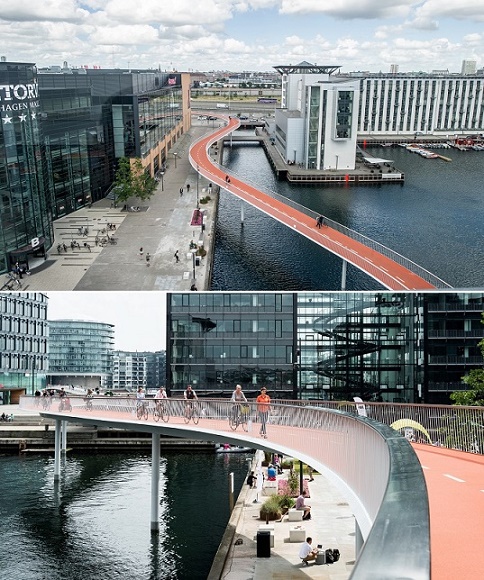
One of the latest directions in the development of the bicycle infrastructure was the construction of super highways for bicycles, which would stretch through the entire central part of the city to the surrounding suburbs and suburban settlements. One example of such a route was a safe and fast cycle route from the central part of Copenhagen to the small town of Albertslund, located 22 kilometers outside the Danish capital.
The route Copenhagen-Albertslund is the first of the planned 500-kilometer network, which in the future will consist of 28 urban cycle roads.
Without cars, it does not mean that you cannot reach the center of the city by car.
Sounds weird? But the answer is simple, if the parking for the car is underground in the center of the city, then having parked the car it will be possible to climb up the elevator.
The given examples may raise doubts about the theoretical possibility of switching to a city “without a car” future, but German specialists from the PRC will help us in clarifying such a future.
So, the BMW Group Technology in Shanghai presented a concept that aims to improve urban mobility by creating a network of closed transit routes that rise on the road for lightweight vehicles with zero emissions - electric cars, scooters, bicycles, segways and others.

The idea is that electric vehicles should receive specialized mini-highways that do not have restrictions peculiar to ground traffic (traffic lights, intersections, etc.), as well as that would be inaccessible to other heavier vehicles.
The project was named BMW Vision E³ Way, in which “E” cubed means “elevated, electric and efficient,” and involves the construction of high-rise tunnels with domed roofs and its own microclimate. They will have a speed limit of 25 km / h, which is quite enough for electric bicycles, taking into account the need to ensure safety. This will allow millions of Chinese cyclists to get to their destination quickly and safely, without sharing traffic with cars on ordinary roads.
Bicycle tunnels will use ramps and gateway systems to connect to ordinary roads, metro stations, interchanges, and shopping centers. They will be allowed only two-wheeled vehicles, which completely eliminates the collision with cars. In addition, they will provide for a “smart” track system that will differentiate traffic by speed.
In fairness it should be noted that similar projects of closed tunnels for light transport were proposed earlier, but only as an idea of little-known authors , and automobile companies, in fact, did not engage in such activities before.
The development of such transport systems creates legitimate doubts about the efficiency of transportation, with the possible need for two vehicles in the city and suburb, with a large city size. The cost of building such light tunnels and the limited speed of movement in them will create inevitable obstacles to the expansion of the city. If the growth peak is reached, a natural question will arise - “which transport to use next?”. One solution is to use 2 in 1 transport.
Right now, this option is increasingly seen in the trends of automotive concepts.
The easiest way is to carry this “personal vehicle” with you.
An interesting option came up with Audi.

The original method of extracting a scooter skateboard in a car’s bumper resembles a retractable furniture shelf. Perhaps such a solution is useful not only for storing the vehicle?

An electric scooter built into the rear bumper can be transformed into a skateboard, but as seen in the picture it is also possible to transport luggage on it.
Before Audi, there was a concept that already hid an electric vehicle in the bumper.

2008 Saturn Flextreme E-Flex Concept Car - a car with built-in hoverboard under the rear bumper.
Sigvey in the car has not received development in serial models yet, but on a less dimensional transport a similar symbiosis is already used. Moreover, Sigvey is not a useless load, but part of the chassis design!

The option of separating the selection of a lighter and more maneuverable element from a large transport is now successfully implemented on the Ninebot Go-kart Kit map, driven by the Ninebot Plus.
The further evolution of the combination of gyroscopic transport with automobile led Ford to one promising patent.

Ford has patented technology to turn one of the wheels of a car into an electric monocycle, which can be used to move in loaded traffic.
Such patents do not look surprising if you know the "pre-history" of the emergence of such ideas.
So concepts with gyro-scooters are not such a rarity in the design world.
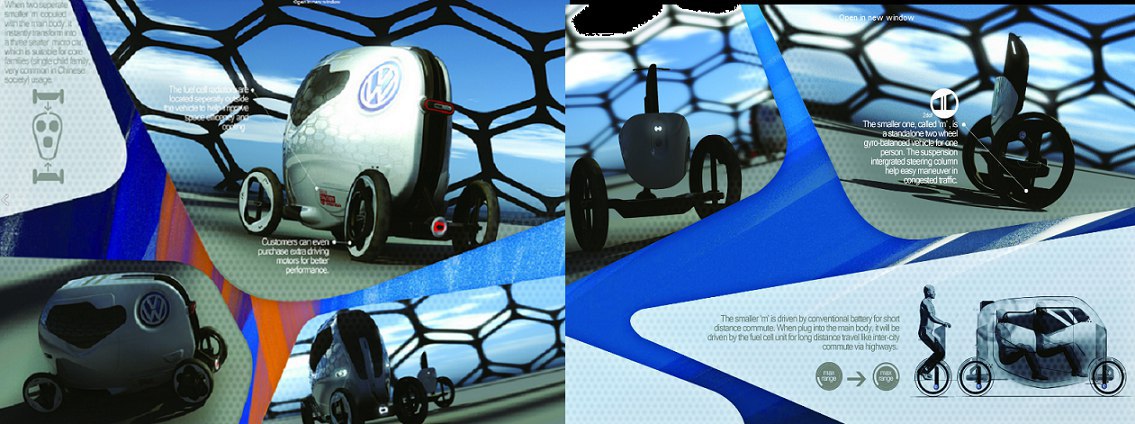
For example Volkswagen MBOLIC concept designer Colin Pan (Colin Pan). The main advantage of MBOLIC is its modular design, one machine includes several vehicles at once. For nearby movements, you can use a single platform like a Segway, however, if the number of passengers increases, this platform connects to another one, the body joins them, and the car becomes three-seater.
The next use of Segway was the DUNO By Ben Herron electric car.
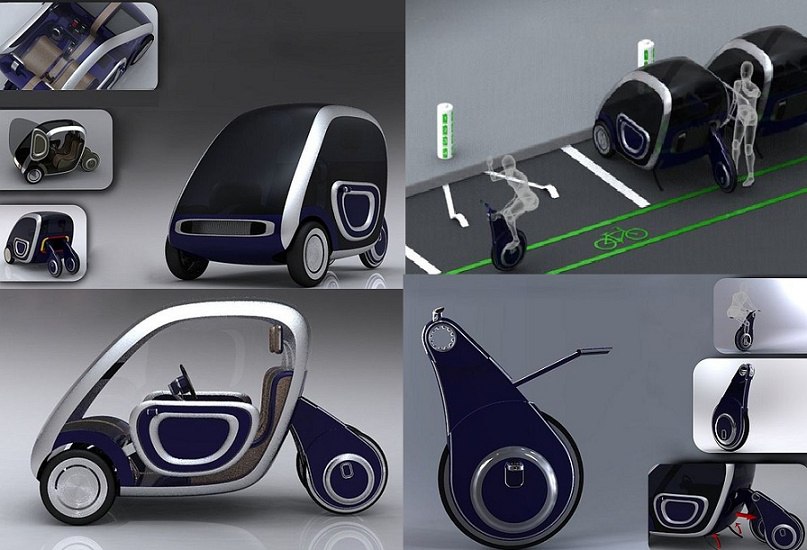
The concept here is simple - this is part of the electric car and part of the one-wheeled monowheel (which is certainly more convenient than the VW MBOLIC variant, since the main part does not become “real estate” when separating one wheel).
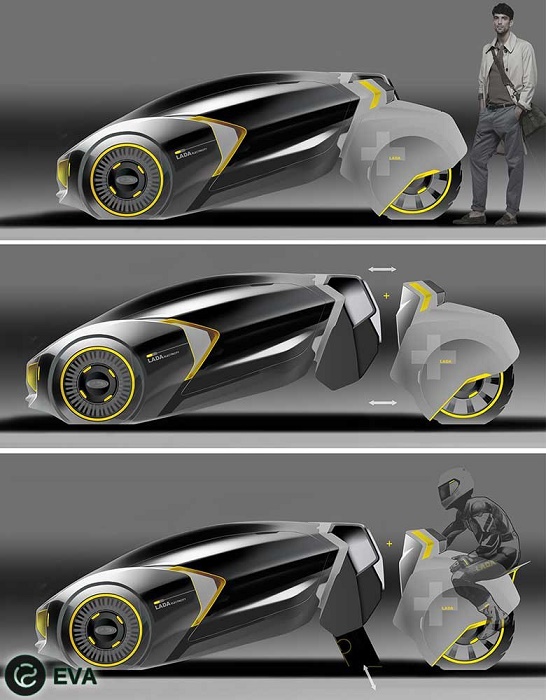
And finally, from the last in this direction ... electric car Lada L-Ego! The figure shows immediately how thoroughly the designers approached the issue of protection, covering almost half of the wheel with a cap.
But do not think that the separation of one wheel, the imagination of designers was limited ...
There were also concepts with detachable motorcycles.

Amsterdam Bimoped Concept (Michael Druchunas). Hybrid car and electrician. It is noteworthy that the author of this project previously worked for Ford and Daimler.
The next project is already domestic.
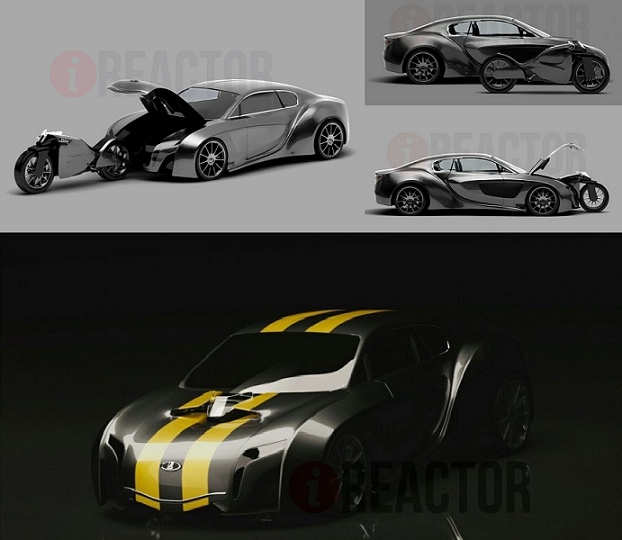
Symbiosis of LADA Vesta of the future and the Ural motorcycle. A similar concept with a motorcycle was patented in 2017 by Ford under the name “multimodal passenger transport”.
The truth is difficult to get rid of the feeling that the inspiration for this concept was clearly taken from the episode of a car stunt from the movie “The Armor of God” with Jackie Chan, where a small three-wheeled mini-moped drove out of the hood of a roadster on the bridge.
Maybe one gets the impression that all these concepts and ideas are not technically viable? And here there is one unusual case from the practice when the transformation of a 4-wheeled car into a 2-wheeled motorcycle was carried out.
This "tuning" did not come from an engineering interest in the possibility of such an alteration, but from the usual desire to survive.

The 2CV was converted into a motorcycle by a French electrician, Emil Liray, to then get out of the Moroccan desert. The car was faulty as a result of the accident, but proved to be suitable for transformation into something resembling a motorcycle.

He made a dwelling out of the car body for the time of construction, then shortened the frame, attached axles and two wheels to it, placed the engine and gearbox in the middle, and made a seat from the rear bumper.
When, after 12 days of refinement, the “motorcycle” was ready, the “Tony Stark” left the desert, and driving onto the highway was discovered by the police. Having received a penalty for the lack of registration documents for the vehicle, the Frenchman was taken to the village, after which he departed for France.
This single fact can not lead to certain thoughts about the future of electric vehicles, because the conversion of an electric vehicle into a motorcycle can be even easier than using one wheel as a monowheel. Of course, one wheel is smaller and more people from the same machine can take advantage of multi-functionality, which is why the question of the best option remains open.
PS - In this case, I considered only the possibility of surface movement, but there are also certain chances for personal flying vehicles (rocket pack). Undoubtedly, the transformation of electric vehicles as a 2 in 1 design improvement will not end. The next stage in the logic of energy saving will surprise no less.
Only registered users can participate in the survey. Sign in , please.
